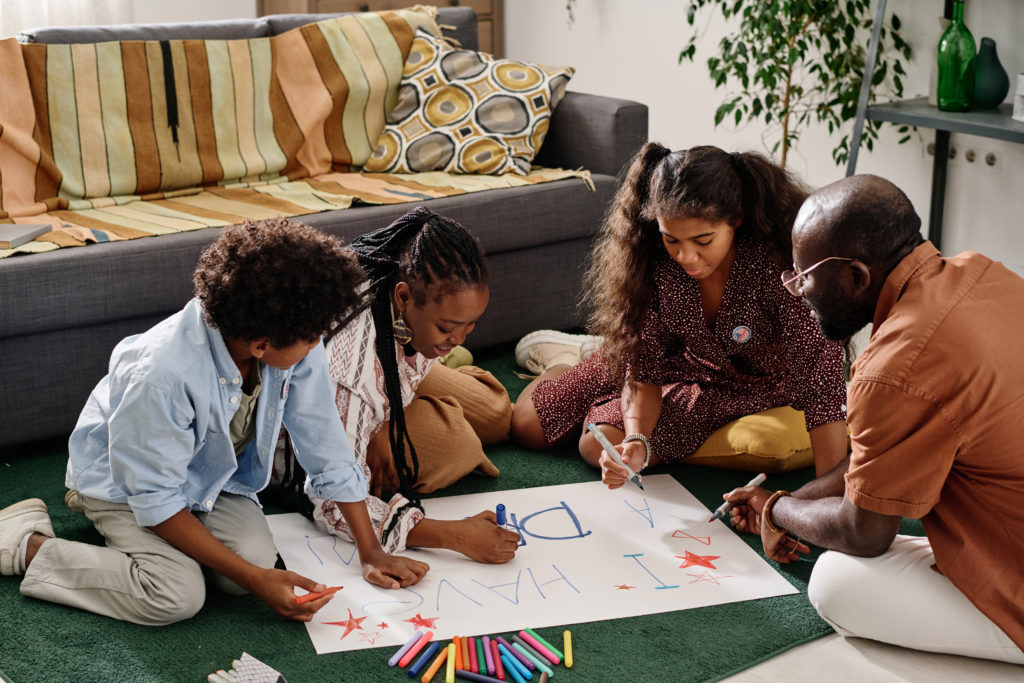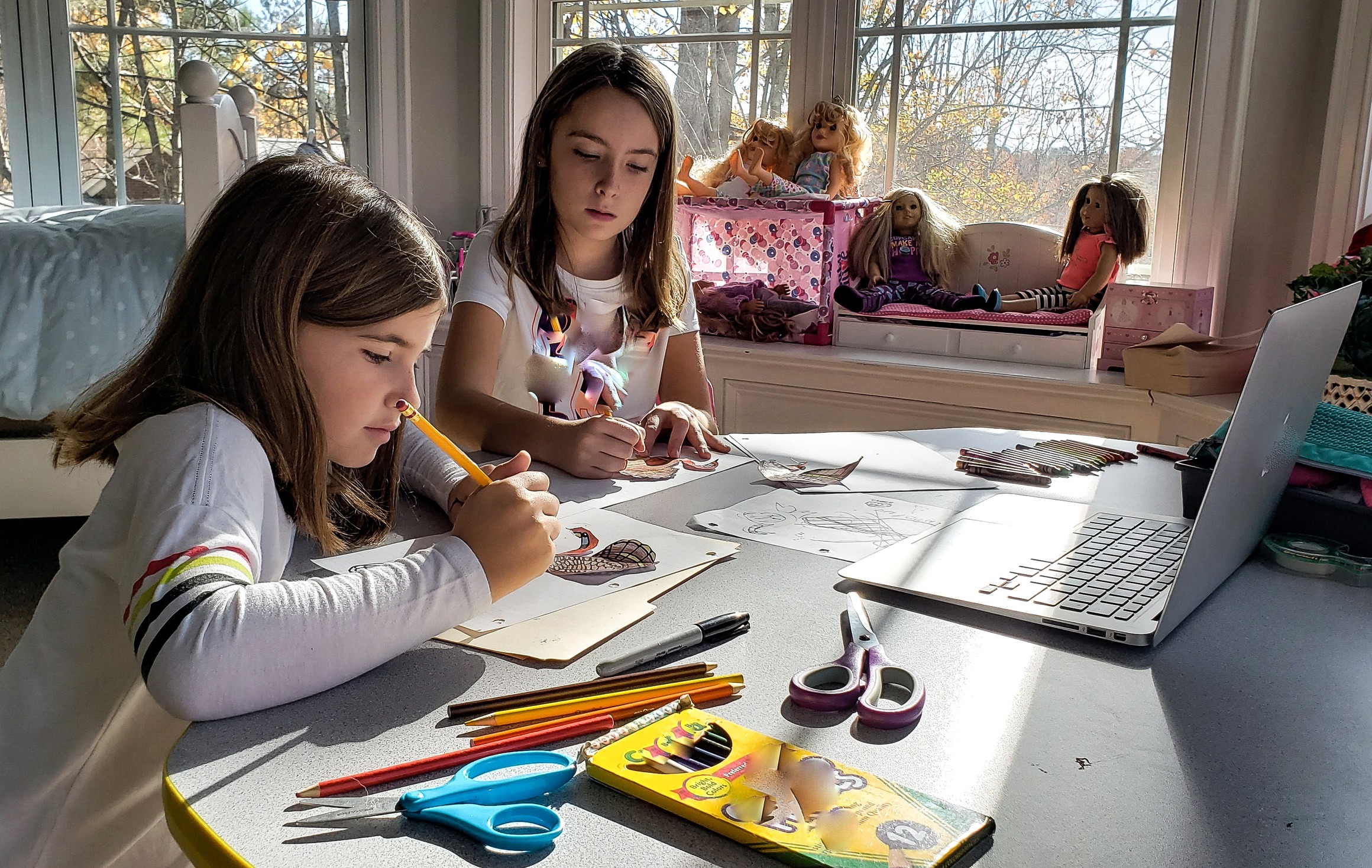Speed Up Homeschooling: Efficient Tips & Tricks
Homeschooling has become increasingly popular, with an estimated 2.5 million homeschoolers in the U.S.
Many families are opting for homeschooling due to its flexibility, personalized learning, and the ability to create a tailored education for their children.
However, homeschooling comes with its own set of challenges.
Staying organized, keeping the child engaged, and ensuring that learning goals are met can be demanding.
To help you navigate the homeschooling journey more efficiently, I have compiled a list of tips and tricks that will help you optimize your homeschooling experience.
Key Takeaways:
- Create a designated learning space to minimize distractions and establish structure.
- Follow a daily schedule to provide consistency and ensure all subjects are covered.
- Map out the school year ahead of time to stay organized and track learning progress.
- Set learning goals together with your child to promote ownership and motivation.
- Take learning beyond the classroom to make education engaging and practical.
Create a Designated Learning Space

One of the first steps in creating an efficient homeschooling environment is to designate a specific area for learning.
This could be a separate room, a corner of a room, or even just a designated space at the kitchen table.
The key is to have a space where all the necessary materials and supplies are organized and easily accessible.
By creating a designated learning space, you can help minimize distractions and create a sense of structure for your child.
Having a dedicated area for homeschooling allows your child to associate that space with learning, making it easier for them to focus and engage in their studies.
Ensure this space is well-stocked with essential homeschooling resources such as textbooks, notebooks, writing utensils, and any other materials needed for their curriculum.
To further enhance the learning environment, consider arranging the space in a way that promotes concentration and productivity. This might include having a comfortable chair and desk, proper lighting, and a clutter-free workspace. By optimizing the physical environment, you can create a conducive atmosphere for effective homeschooling.
Additionally, personalizing the learning space with inspiring quotes, artwork, or a bulletin board can further motivate and engage your child in their studies.
Ensure that the space is organized and visually appealing, as this can positively impact their learning experience.
Remember, the designated learning space should be separate from other areas used for leisure or relaxation. This separation helps establish boundaries between schoolwork and free time, allowing your child to mentally shift gears and focus on their education.
Creating a designated learning space not only provides a dedicated area for homeschooling but also helps cultivate a sense of routine and structure in your child’s daily life.
This space serves as a visual reminder that it’s time to focus on learning, helping your child transition into a productive mindset.
By following these homeschooling tips, such as creating a designated learning space, you can optimize your child’s learning environment and set the stage for successful homeschooling.
Follow a Daily Schedule

When it comes to homeschooling, having a daily schedule is crucial for maintaining organization and ensuring that all necessary subjects and activities are covered.
A well-structured schedule provides the framework for your child’s learning journey and helps them develop a routine.
Creating a daily schedule can be made more effective by implementing a few strategies. One such strategy is color-coding activities by subject or type.
Assigning different colors to various subjects or types of activities can help your child easily identify and transition between different tasks. This visual representation can make the schedule more engaging and easier to follow.
Another method to track multiple daily schedules for different children is by using swimlanes. Imagine each child having their own lane within the schedule, allowing for individualized planning.
This approach ensures that each child’s unique academic needs and interests are accounted for within the overall homeschooling curriculum.
Additionally, consider creating a flowchart to help children move through their day smoothly. A flowchart visually represents the sequence of tasks, providing a step-by-step guide for your child’s daily activities.
This visual aid can be particularly helpful for younger children who may struggle with reading or interpreting a traditional schedule.
By following a daily schedule, you provide structure and routine to your child’s homeschooling experience, aiding their focus and productivity. This consistency fosters better time management skills and allows for a more efficient use of learning hours.
Map out the School Year Ahead of Time

When it comes to homeschooling, one of the keys to success is planning. By mapping out the school year ahead of time, you can ensure that you cover all the necessary topics and projects and stay organized throughout the year.
This strategy not only helps you track progress but also allows you to break down goals into manageable steps.
There are several methods you can use to map out your homeschool curriculum and goals. Consider using org charts, mind maps, roadmaps, or flowcharts to visualize your plans.
These visual tools provide a clear overview of the entire year, helping you see the big picture and keep track of important milestones.
Whether you prefer a structured or flexible approach, mapping out the school year allows you to set clear learning objectives for each subject and ensure that you don’t miss any key topics.
It also helps you allocate your time and resources effectively, making homeschooling more efficient and productive.
So, take the time to sit down and create a roadmap for your homeschooling journey. Plan out your curriculum, set goals, and break them down into smaller tasks.
By mapping out the school year ahead of time, you’ll be better prepared, organized, and confident in your homeschooling adventure.
Set Learning Goals Together

Collaborating with your child to set learning goals is a fundamental aspect of homeschooling.
By involving your child in the goal-setting process, you can empower them to take ownership of their education and make their learning experience more meaningful.
When establishing goals, consider state or national requirements, your educational philosophy, and your child’s age and abilities.
This collaborative approach also presents an opportunity to teach your child goal-setting skills and best practices, such as using the SMART formula.
Setting goals together fosters a sense of purpose and motivation in your child’s homeschooling journey.
It helps them understand the value of each learning objective and enables them to reflect on their progress.
By engaging in this process, you not only promote their academic growth but also support their development in self-discipline and self-motivation.
To illustrate the SMART formula, let’s take an example from our homeschooling experience:
- Specific: Instead of setting a general goal like “improve math skills,” we set a specific goal such as “learn multiplication tables up to 10.”
- Measurable: We measure progress by tracking how quickly and accurately our child completes multiplication drills.
- Achievable: We ensure that our goal is attainable by considering our child’s current math abilities and providing appropriate resources and support.
- Relevant: We make sure the goal aligns with our child’s curriculum and overall academic development.
- Time-bound: We set a deadline, like achieving the goal within six weeks, to create a sense of urgency and maintain focus.
By involving your child in the goal-setting process and applying the SMART formula, you can foster a sense of purpose and empower them to take charge of their own education.
Together, you can create meaningful and achievable learning goals that will elevate your homeschooling experience.
Take Learning Beyond the Classroom

One of the advantages of homeschooling is the flexibility to learn outside of a traditional classroom setting.
As a homeschooling parent, I encourage you to embrace this opportunity and incorporate real-world learning into your curriculum.
By taking learning beyond the classroom, you can make education more engaging, practical, and enjoyable for your child.
One way to extend learning beyond the classroom is through interactive activities such as playing board games.
Board games can teach valuable skills like problem-solving, critical thinking, and strategy, all while having fun as a family.
Additionally, encourage your child to practice life skills like cooking and household management.
Cooking together provides real-world application of math and science concepts, while managing household tasks fosters responsibility and independence.
Written communication is an essential skill in today’s digital age. Encourage your child to write emails to friends and family as a way to practice their writing skills and stay connected.
Not only does this enhance their communication abilities, but it also provides a fun and meaningful way to engage with loved ones.
Local businesses and attractions offer unique opportunities for hands-on learning. Consider planning field trips to museums, historical sites, nature preserves, or science centers.
These outings allow your child to experience learning in a different environment and make connections between what they learn at home and the world around them.
Engaging in community activities is another way to take learning beyond the classroom. Look for volunteer opportunities, community service projects, or workshops that align with your child’s interests.
By participating in these activities, your child can develop valuable social skills, empathy, and a sense of civic responsibility.
Remember, homeschooling provides the flexibility to tailor your child’s education to their unique needs and interests.
By incorporating real-world learning opportunities, you can enhance their academic growth, foster a love for learning, and prepare them for success in the real world.
Make Learning a Family Activity

When it comes to homeschooling, involving the whole family can make the learning experience more enjoyable and effective.
By finding activities or subjects that everyone can participate in, you can foster a love for learning and create lasting memories.
- Read together: Pick a book that interests the whole family and take turns reading aloud. This can not only improve reading skills but also spark meaningful discussions.
- Explore a new hobby: Choose a hobby that the family can engage in together, whether it’s painting, gardening, or cooking. This not only allows for learning new skills but also promotes teamwork and bonding.
- Make crafts: Get creative and make crafts as a family. It can be as simple as creating handmade cards or as elaborate as building a birdhouse. Crafting together promotes creativity and problem-solving.
- Go on family outings: Plan outings to museums, parks, or historical sites. These trips provide hands-on learning experiences and allow the family to explore new places together.
- Learn a new language together: Choose a foreign language that interests your family and learn it together. Use language learning apps, watch movies, or practice conversations as a family. Learning a new language broadens horizons and enhances communication skills.
By making learning a family activity, you can create a positive and engaging environment for homeschooling, and your child will be more motivated to learn.
Remember, homeschooling is not just about academics; it’s about holistic growth.
Collaborate with Other Homeschoolers

Homeschooling doesn’t mean you have to do it alone. There are homeschooling communities and networks where you can connect with other homeschooling families.
Collaborating with other homeschoolers can provide support, resources, and opportunities for your child to socialize and learn from others.
Join local homeschool groups, attend homeschool co-ops, or participate in online forums to network and share ideas with other homeschoolers.
By collaborating with other homeschoolers, you gain access to a wealth of knowledge and experience.
You can exchange tips, curriculum recommendations, and teaching strategies.
Networking with other homeschooling families can also lead to valuable friendships for both you and your child.
Homeschooling communities often organize field trips, workshops, and events that allow children to interact and learn together.
These activities provide a sense of belonging and community, which is important for social development.
Ease into School
Transitioning back into the homeschool routine after breaks can be challenging. Instead of diving right back into a full load of schoolwork, consider easing into it gradually.
Start with a few subjects the first week and then add more subjects each week as you and your child adjust.
This gradual approach can help prevent overwhelm and ensure a smoother transition back into homeschooling.
Find Out Why You’re Behind

When it comes to homeschooling, it’s not uncommon to fall behind at times. Before you start panicking or feeling overwhelmed, take a step back and reflect on why you might be behind.
There can be various reasons for falling behind in homeschooling, such as illness, unexpected circumstances, or even procrastination. It’s important to identify the root cause so that you can address it effectively.
Take some time to analyze your homeschooling journey and consider the factors that might be contributing to your current situation.
Are there any external factors affecting your routine?
Are there specific subjects or topics that are proving to be challenging?
By understanding why you’re behind, you’ll be better equipped to come up with a plan to catch up. Remember, the goal is to find practical solutions rather than dwelling on the setback.
Instead of stressing about what has already happened, focus on finding ways to move forward. With determination and a positive mindset, you can find the strategies and resources needed to get back on track.
Assess the Situation

Once you have identified the reasons behind falling behind, it’s important to assess the situation and evaluate what subjects or areas need catching up.
Take note of the specific topics or skills that require attention, as this assessment will serve as a guide for creating a catch-up plan and prioritizing your efforts.
It’s common for homeschooling students to face challenges or struggle in certain subjects or areas.
Identifying these areas of weakness early on can help you address them effectively and ensure your child’s progress.
For example, if your child is struggling with math concepts, you may need to dedicate more time and resources to this subject.
On the other hand, if they are excelling in language arts, you can focus your efforts on other subjects that need more attention.
By assessing the situation and identifying the specific areas that require catching up, you can tailor your approach to meet your child’s individual needs and provide targeted support where it is needed most.
This will help maximize their learning potential and ensure a well-rounded education.
Remember, homeschooling may have its disadvantages and challenges, but by addressing the areas that need catching up, you can overcome these obstacles and create a successful homeschooling experience for your child.
Make a New Schedule for Catching Up

To catch up on homeschooling, I recommend creating a new schedule that includes dedicated catch-up sessions.
This will help you stay organized and ensure that you make progress in catching up. Allocate specific time slots for the subjects or areas that need extra attention.
By creating a structured schedule, you can prioritize the subjects or topics that require more focus. This will allow you to allocate sufficient time and resources to address any gaps in your child’s education.
Start by assessing the subjects or areas where your child needs to catch up. Take note of the specific topics or skills that require additional attention.
This assessment will serve as a guide for creating a catch-up plan and prioritizing your efforts.
Once you have identified the areas that need catching up, design a schedule that accommodates dedicated time for each subject.
Make sure to create realistic time frames that consider your child’s learning pace and avoid overwhelming them.
Remember, consistency is key when catching up on homeschooling. Stick to your new schedule, and encourage your child to stay committed and focused.
Celebrate their achievements along the way to keep them motivated and engaged.
The image above visually represents the importance of a well-structured schedule in catching up on homeschooling. It serves as a reminder of the techniques and tips discussed in this section.
Conclusion
Homeschooling offers a unique and effective educational approach for families, allowing parents to tailor their child’s learning experience.
To ensure homeschooling success, I recommend implementing these efficient tips and tricks:
- Create a designated learning space to minimize distractions and provide structure for your child’s education.
- Follow a daily schedule to establish a routine and cover all necessary subjects and activities.
- Map out the school year ahead of time using visual aids like org charts or roadmaps, ensuring that important topics and projects are covered.
- Set learning goals together with your child, fostering a sense of ownership and making education more meaningful.
- Take learning beyond the classroom by incorporating real-world experiences and practical skills into your curriculum.
- Make learning a family activity to engage the whole family and create a love for learning.
- Collaborate with other homeschoolers through local groups or online forums, providing support and resources.
- Ease into school after breaks by gradually adding subjects to prevent overwhelm and ensure a smoother transition.
By implementing these strategies, you can create an optimal homeschooling environment that sets your child up for success.
Remember, homeschooling is a journey, and finding the best way for your family may require some trial and error. Stay flexible, stay motivated, and embrace the freedom and flexibility that homeschooling offers.
FAQ
What is the best way to homeschool?
The best way to homeschool involves creating a designated learning space, following a daily schedule, mapping out the school year ahead of time, setting learning goals together, taking learning beyond the classroom, making learning a family activity, collaborating with other homeschoolers, and easing into school after breaks.
How do I create a designated learning space?
Designate a specific area for learning, whether it’s a separate room, a corner of a room, or a designated space at the kitchen table. This provides a sense of structure and minimizes distractions. Organize all necessary materials and supplies in this space.
How do I follow a daily schedule for homeschooling?
Create a daily schedule that provides structure and routine. Consider color-coding activities, using swimlanes for multiple schedules, and creating flowcharts to help children navigate their day. This ensures that all subjects and activities are covered and helps children stay focused.
Why is mapping out the school year ahead of time important in homeschooling?
Mapping out the school year allows you to stay organized and track progress. Use org charts, mind maps, roadmaps, or flowcharts to visualize your curriculum and goals. This helps you see the big picture, break down goals into manageable steps, and ensure that important topics and projects are covered.
How can I set learning goals together with my child?
Involve your child in the goal-setting process to foster ownership and make learning more meaningful. Consider state or national requirements, your educational philosophy, and your child’s abilities. Teach goal-setting skills using the SMART formula.
How can I take learning beyond the classroom in homeschooling?
Incorporate real-world learning opportunities such as playing board games, practicing life skills, writing emails, visiting local businesses, or engaging in community activities. This makes learning more engaging and practical for your child.
How can I make learning a family activity in homeschooling?
Find activities or subjects the whole family can participate in, such as reading together, exploring hobbies, making crafts, going on outings, or learning a new language. This fosters a love for learning and creates lasting memories.
How can collaboration with other homeschoolers benefit me?
Join homeschooling communities, attend co-ops, or participate in online forums to connect with other homeschooling families. Collaboration provides support, resources, and opportunities for your child to socialize and learn from others.
How can I ease into school after breaks in homeschooling?
Instead of diving into a full load of schoolwork, transition gradually. Start with a few subjects the first week and add more subjects each week. This prevents overwhelm and ensures a smoother transition back into homeschooling.
How can I find out why I’m behind in homeschooling?
Reflect on the reasons behind falling behind, such as illness or procrastination. Understanding the root cause helps you address the issue and come up with a plan to catch up.
How can I assess the situation if I’m behind in homeschooling?
Evaluate the subjects or areas that need catching up. Take note of specific topics or skills that need attention. This assessment serves as a guide for creating a catch-up plan and prioritizing efforts.
How can I make a new schedule for catching up in homeschooling?
Create a new schedule with dedicated catch-up sessions. Allocate specific time slots for subjects or areas that need extra attention. This helps stay organized and ensures progress in catching up.
What is the best way to homeschool?
By implementing these efficient tips and tricks, such as creating a designated learning space, following a daily schedule, mapping out the school year, setting learning goals, taking learning beyond the classroom, making learning a family activity, collaborating with other homeschoolers, and easing into school after breaks, you can create an optimal homeschooling environment and set your child up for success.







